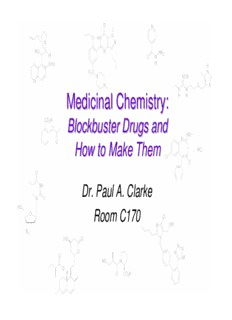
Aromatic Heterocyclic Chemistry F12HSC - University of York PDF
Preview Aromatic Heterocyclic Chemistry F12HSC - University of York
MMeeddiicciinnaall CChheemmiissttrryy:: BBlloocckkbbuusstteerr DDrruuggss aanndd HHooww ttoo MMaakkee TThheemm Dr. Paul A. Clarke Room C170 Resources ‘Organic Chemistry’ by Clayden, Greeves, Warren and Wothers. ‘Top Drugs: Top Synthetic Routes’ by John Saunders. Oxford Primer http://www.york.ac.uk/res/pac/teaching/medchem.html SSccooppee ooff tthhee CCoouurrssee In the limited time available we will look at how medicinal chemists have developed therapies for a number of human diseases. A brief introduction to the disease area and the biological target will be given. This will be followed by an analysis of the rational design and syntheses of a number drug molecules. Particular emphasis will be placed on the organic chemistry used in each synthesis. Learning Objectives 1) To appreciate the general strategies used by medicinal chemists for the synthesis/development of potential drug candidates. 2) To know the structures of the drug molecules discussed and to have a basic understanding of their mode of action. 3) To gain a mechanistic understanding of the synthetic procedures utilised to prepare drugs discussed in this course. 4) Be able to identify good and bad points in the synthesis of a drug molecule. Examples of Pharmaceuticals Course Outline Introduction to medicinal chemistry research. Control of Blood Pressure: ACE inhibitors: captopril Blockade of Angiotensin-II receptors: losartan Anti-ulcer remedies: Antagonists of histamine: cimetidine, ranitidine Erectile Disfunction: Inhibitors of type-5 CGMP Phosphodiesterase: viagra The future: natural products, chemical space and diversity IInnttrroodduuccttiioonn:: Medicinal Chemistry Research Medicinal Chemists aim to synthesise small molecules which will interact with biological systems to produce an effect which will provide relief from or cure for a human disease or ailment. There are in general 3 strategies: Most drug molecules synthesised conform to a set of emprical observations noted by Lipinski. This has since become known as Lipinski’s Rule of Five. These are that, in general, an orally active drug has: There are two typical misunderstandings with these rules. 1) Molecules that conform to this rule are not automatically drug-like. 2) This rule was derived for drugs and not for lead structures, which usually have a lower molecular weight, fewer rings, fewer rotatable bonds, and a lower lipophilicity. However, medicinal chemists are prone to forget this! CCaassee SSttuuddiieess
Description: